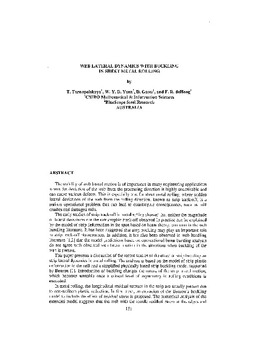| dc.contributor.author | Tarnopolskaya, T. | |
| dc.contributor.author | Yuen, W. Y. D. | |
| dc.contributor.author | Gates, D. | |
| dc.contributor.author | deHoog, F. R. | |
| dc.contributor.other | International Conference on Web Handling (2005) | |
| dc.date.accessioned | 2019-11-08T22:57:03Z | |
| dc.date.available | 2019-11-08T22:57:03Z | |
| dc.date.issued | 2005-06 | |
| dc.identifier | oksd_icwh_2005_tarnopolskaya | |
| dc.identifier.citation | Tarnopolskaya, T., Yuen, W. Y. D., Gates, D., & deHoog, F. R. (2005, June). Web lateral dynamics with buckling in sheet metal rolling. Paper presented at the Eighth International Conference on Web Handling (IWEB), Stillwater, OK. | |
| dc.identifier.uri | https://hdl.handle.net/11244/321901 | |
| dc.description.abstract | The stability of web lateral motion is of importance in many engineering applications where the deviation of the web from the processing direction is highly undesirable and can cause various defects. This is especially true for sheet metal rolling, where sudden lateral deviations of the web from the rolling direction, known as strip track-off, is a serious operational problem that can lead to catastrophic consequences, such as mill crashes and damaged rolls. | |
| dc.description.abstract | The early studies of strip track-off in metal rolling showed that neither the magnitude of lateral deviations nor the catastrophic track-off observed in practice can be explained by the model of strip deformation in the span based on beam theory, common in the web handling literature. It has been suggested that strip buckling may play an important role in strip track-off phenomenon. In addition, it has also been observed in web handling literature (1,2] that the model predictions based on conventional beam bending analysis do not agree with observed web lateral motion in the situations when buckling of the web is present. | |
| dc.description.abstract | This paper presents a discussion of the recent studies of the effect of strip buckling on strip lateral dynamics in metal rolling. The analysis is based on the model of strip plastic deformation in the mill and a simplified physically based strip buckling model suggested by Benson [l]. Introduction of budding changes the nature of the strip lateral motion, which becomes unstable once a critical level of asymmetry in rolling conditions is exceeded. | |
| dc.description.abstract | In metal rolling, the longitudinal residual stresses in the strip are usually present due to non-uniform plastic reduction. In this paper, an extension of the Benson's buckling model to include the effect of residual stress is proposed. The numerical analysis of the extended model suggests that the web with the tensile residual stress at the edges and compressive stress in the middle is less susceptible to instability compared to the web with compressive residual stresses at the edges and the case without residual stress. | |
| dc.format | application/pdf | |
| dc.language | en_US | |
| dc.publisher | Oklahoma State University | |
| dc.rights | In the Oklahoma State University Library's institutional repository this paper is made available through the open access principles and the terms of agreement/consent between the author(s) and the publisher. The permission policy on the use, reproduction or distribution of the article falls under fair use for educational, scholarship, and research purposes. Contact Digital Resources and Discovery Services at lib-dls@okstate.edu or 405-744-9161 for further information. | |
| dc.title | Web lateral dynamics with buckling in sheet metal rolling | |
| osu.filename | oksd_icwh_2005_tarnopolskaya.pdf | |
| dc.type.genre | Conference proceedings | |
| dc.type.material | Text | |
